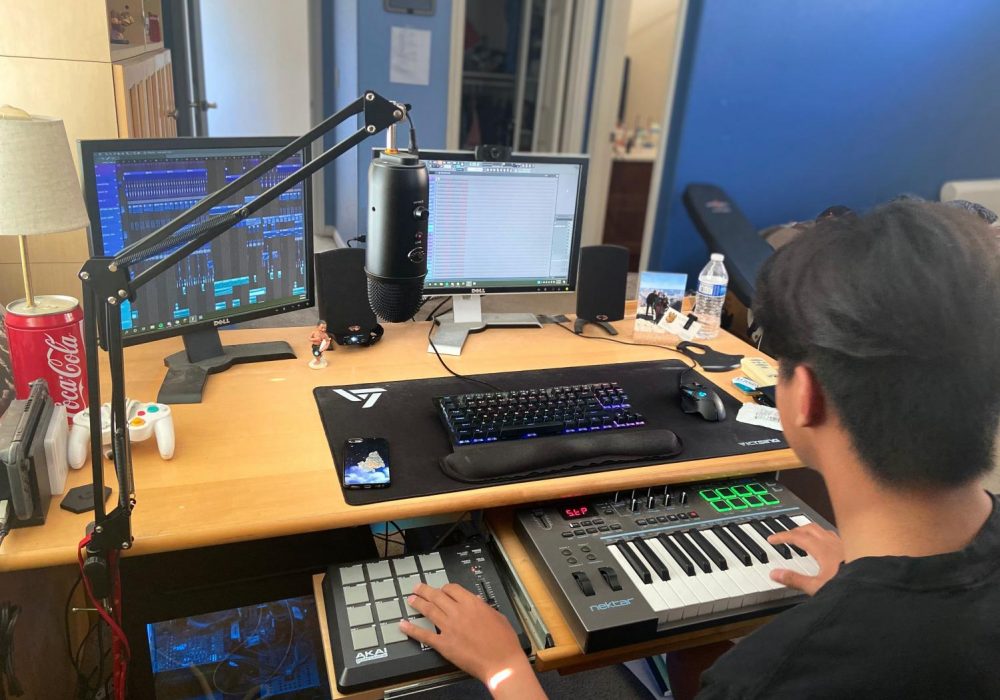Reyes synthesizes world through producing music
May 10, 2021

While in English preparing for a Socratic seminar, two students each boasted to the Zoom class, “My favorite song is ‘Pringole’ by DJhibs.” Their English teacher, Katie Wu, entertained the comment and asked for the link to the artist’s page in the chat. There was Nate Reyes’ (10) SoundCloud and his hit “Pringole.” Students sitting in that class could not comprehend it at the time, but they were witnessing the complex inner workings of the Pringole nation.
Reyes’ love for music began in elementary school at an orchestra concert. In fourth grade, as he listened to the Del Norte High School orchestra, he was awed by the richness of the instruments and the dynamic sounds he was hearing.
“I don’t even remember what they were playing but I do remember that I didn’t know music could sound so beautiful and complex,” Reyes said. “And I knew from that point on that music would be a huge part of my life whether it be just listening, performing or even making it.”
After the orchestra concert, he didn’t hesitate to join Willow Grove Elementary School’s fifth-grade band, and he has been involved in band ever since. In middle school, he discovered his love of jazz music and later tried to create his own jazz compositions using complex chord progressions.
“The way I listen to music now is that there’s a theory part, which is the harmony and melody; there’s the production, and then there’s the lyrics,” Reyes said. “When I first started, I was trying to hone in on that theory part without putting in a lot of effort into the production part.”
In order to develop a more holistic understanding of music, he strayed from making jazz pieces. One of his first influences after that transition was his brother who began making digital music when Reyes was in elementary school. Listening to his brother’s electronic beats captivated him and having another artist in the family gave Reyes the necessary equipment and support to start making his own music.
Initially, his music was a way to make his friends laugh. His first song was entitled “ASS God” because he thought “it’s just a funny word.” Some notable samples throughout the track are the shouts of YouTuber Keemstar while he plays Minecraft, a random sitar, and a cut-up SoundFont of a man spelling the Pokemon species Dogars rearranged to spell ASS God.
The track helped him learn the basics of his audio software like putting elements and sounds into the mixer, using effects like reverb and delay, making piano rolls, and using MIDI, an industry-standard that connects computers to an artist’s instruments. His first song was instrumental in making him realize that he could actually make fun music, “even if it’s really bad,” Reyes said.
Much like a video game, Reyes believed as he learned new techniques and developed more intricate tracks, he “leveled up” in his music career. Namely, “Yado in theme lofi remix” and “National Park” are tracks he put more effort into and created more dynamic pieces than his usual 20 bar loops, or measures.
Reyes said from then on he was able to produce tracks he was actually proud of. “A Glimmer,” for example, features an instrumental version with a beat inspired by the rapper Lil Uzi Vert, while the lyrical version has vocals inspired by Playboi Carti. This song is one of his favorite trap beats because he learned how to take an already existing melody and make it into his own by chopping, reversing and rearranging it.
“If I had a skill tree like in a video game, and there’s [three branches], sound design, synths, and sampling, I think that the sample skill tree leveled up [with “A Glimmer”],” Reyes said.
Despite enjoying making trap beats like “A Glimmer,” he said he prefers to stick to his roots and create EDM tracks. Where the process differs between the two is how synthesizers are used in the tracks. In an EDM beat, the melody is used as a percussive instrument.
There are, however, advantages to creating trap beats over EDM Reyes said, one being the profitability of them as they are in higher demand by up-and-coming rappers. Reyes knows other artists who sell their work and can create up to four songs in just one week.
“[I] spend [about] three to four weeks just making one track. For me personally, [I prefer] to hone in on the quality of the music,” Reyes said. “Their music isn’t bad, but I just think that it’s really important to refine your music in [a] four-week span or even longer.”
Oftentimes, a lack of motivation to create a difficult, inspired project can prevent him from making music during lulls of creativity which can last upwards of two months. He has more than 80 abandoned projects in his folders from those dry periods, but nothing is more encouraging than when he finally gets a spark of inspiration from a new song, a suggestion from somebody, or an interesting sample.
“I know when it’s going to be a finished track when right at the beginning of when I’m making it, I hear the entire track in my mind,” Reyes said. “And [I think], ‘Dude, this is gonna be a banger.’”
One consistent source of inspiration is Reyes’ brother who often either collaborates with Reyes to rap over his tracks or offers suggestions as to what he should create next. His brother’s challenge for Reyes to make a poppy beat was the catalyst to his “game-changing” song, “Pringole.”
On this track, he started with a flute sample and used basic chords to create a melody. He then utilized a technique he learned from making 808s for the first time and looped his own voice saying “yo” instead of looping a kick, or the sound of a bass drum. Reyes once again leveled up with this track and said he learned how to sample more dynamically and interestingly.
“[The song is] just legendary,” Baron Egaran (10), a supporter since the conception of DJhibs and an avid “Pringole” fan, said. “It’s just classic. When I think of Nate’s music, I usually just think of ‘Pringole.’”
The song “Pringole” started as a joke but quickly became a phenomenon within Egaran and Reyes’ friend group. The word pringole became embedded into each person’s vocabulary, the generic flute sound he used in his beat blared in Discord calls like a national anthem at a football game, and their personal inside joke had crept its way into their high school English class. When the lyrical version was uncovered by the group, the Pringole nation had cemented itself as a fixture of the group connecting them through a song that began as a joke.
Following the release of “Pringole,” Reyes began to listen to EDM and developed a deeper appreciation for music and its infinite genres.
Reyes said he believes his taste in music has strayed from mainstream pop music and broadened to EDM, jazz, hip hop, and even country music.
Although he still didn’t completely love country music, he had developed a newfound respect for it through watching videos on the Trucker Country subgenre. The context he learned behind Trucker Country was that during the 1950s, President Eisenhower developed interconnected highways that opened up job opportunities for thousands of truckers. From the 1960s to the ’70s, record labels began to create music for truckers and their lonely night drives.
Understanding the meaning of songs as well as the sound production and design behind them made Reyes more compassionate towards other artists and their dedication to their work. For example, as he drew ideas and learned techniques from producers like Kanye West, he also discovered that the story in West’s work was true artistry. Through music, West has been known to be open about his struggles including, Reyes says, in 808s & Heartbreak, an album created following the death of his mom and break up with his fiance.
“It’s a massive shift in the tone of his music and the song titles tell a lot,” Reyes said. “You can tell just by the instrumentals that Kanye is in pain.”
A polarizing figure today, the American rapper and producer has found himself the subject of countless controversies including his interruption of Taylor Swift’s MTV Music Video Award (VMA) speech, his unsuccessful bid for president, and more recently, his divorce from Kim Kardashian. Reyes, however, said he believes that as unlikable as West can be, his ability to tell a story through the music he creates gives him a redeeming charm. His career helped Reyes read people as more than what they appeared as at face value. Reyes strives to mirror the intricacy and profoundness of West as he continues to mature as an artist.
Egaran, who is usually one of the first people to hear Reyes’s finished projects, has already noticed a shift in Reyes’s music that has caused it to become more than just creating entertaining pieces.
“I remember in the beginning he would add random things to his music just because it sounded good,” Egaran said. “Later on, he would add things that meant things and actually had abstract meaning.”
Reyes’s music and real-life experiences have become intertwined. His wonder as a child at the booming orchestra to his study of music theory and 36 completed tracks on DJhibs came full circle when his siblings recreated an old rap from 2012 for their father’s birthday this year. With music and its many applications, Reyes said that his own world has become a little more colorful.
“Ever since I started making music, I listen to music as if it had layers,” Reyes said. “It’s like if you’re colorblind and if you were to put on colorblind glasses, you see the world how it [really] is.”


